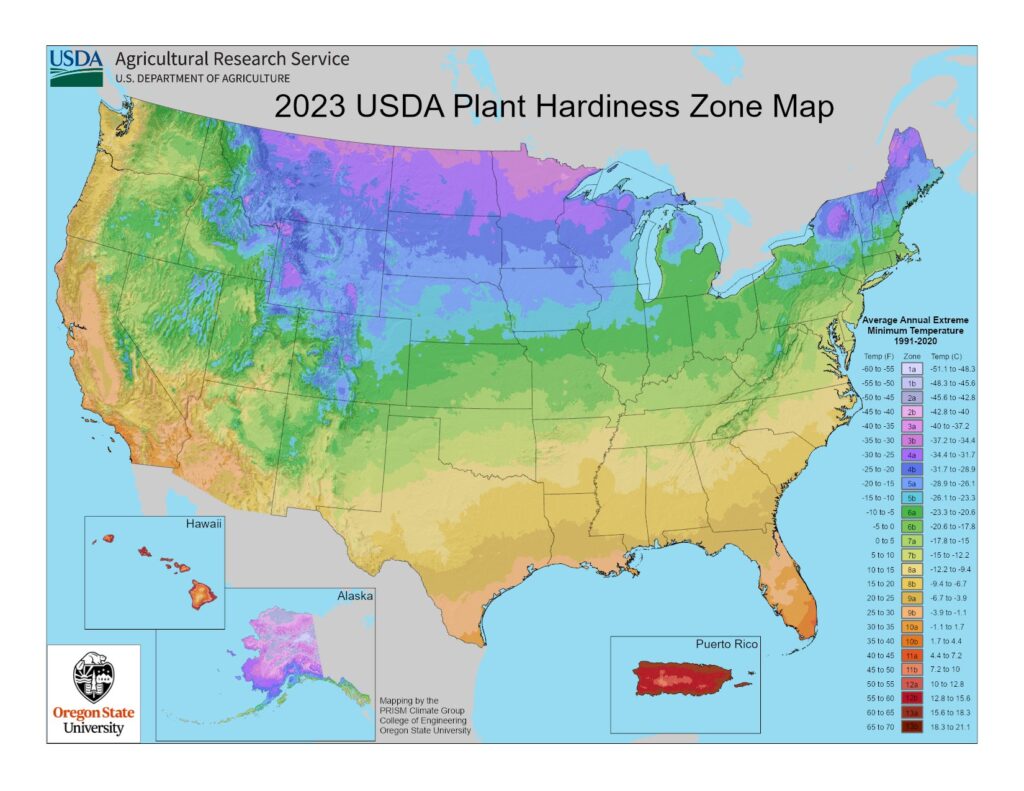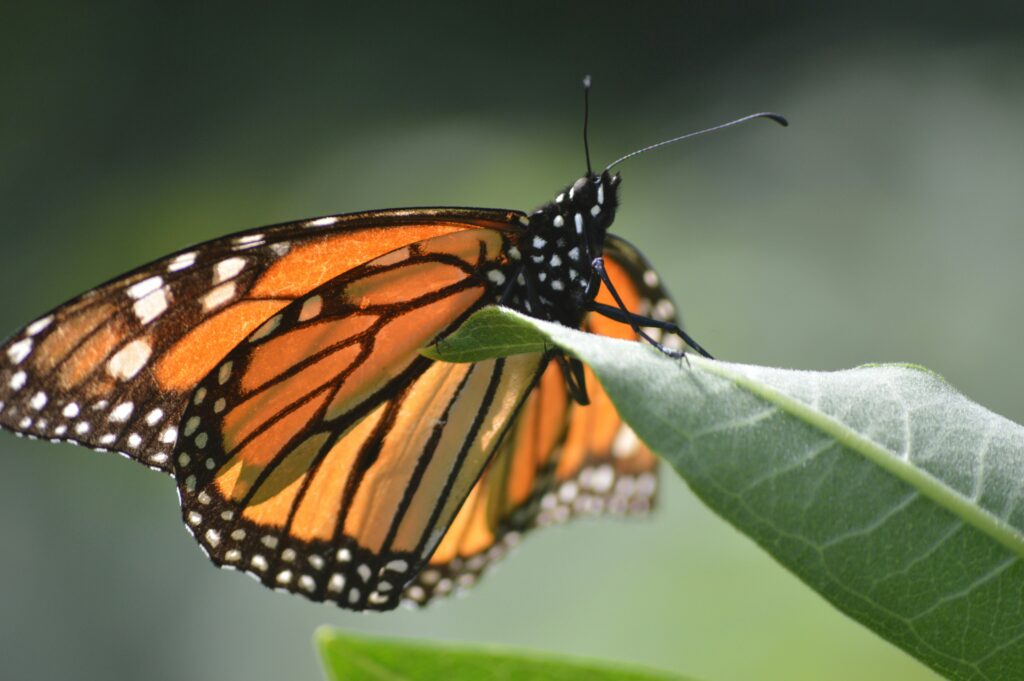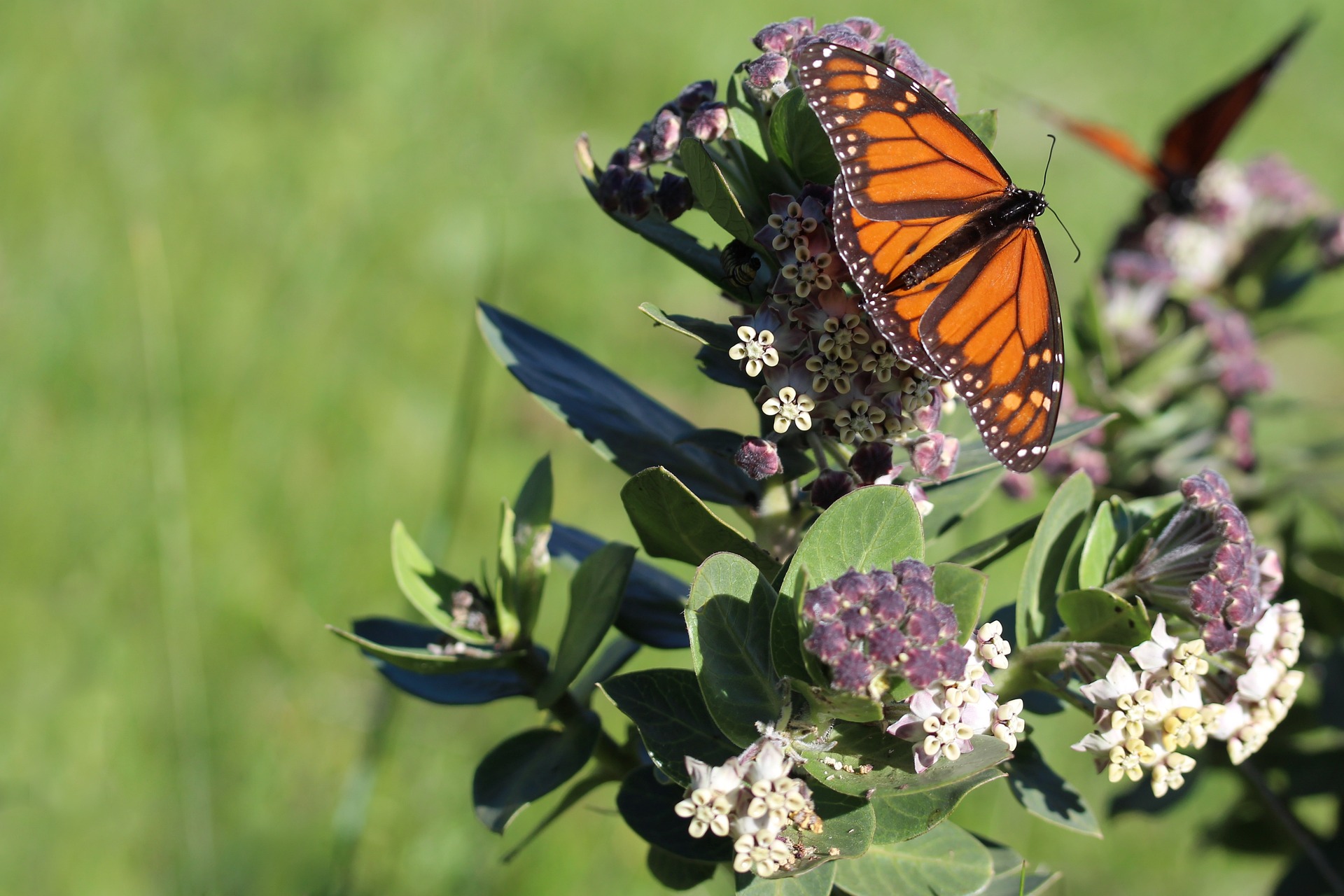Milkweed, or Asclepias spp., is a diverse group of plants belonging to the Asclepiadaceae family. Native to North America, Milkweed encompasses several species with distinct characteristics and growing requirements.

Milkweed plays a crucial role in the lifecycle of monarch butterflies (Danaus plexippus). Monarchs lay their eggs exclusively on Milkweed plants, and the caterpillars feed on Milkweed leaves. Planting Milkweed in your garden lets you contribute to monarch conservation efforts and support these iconic butterflies throughout their journey.

Annual or Perennial?
Milkweed can be both annual and perennial, depending on the species and the growing conditions. In colder climates (typically USDA hardiness zones 3-9), many Milkweed species are perennial, meaning they return year after year from the same root system.
In warmer regions, some Milkweed species may act as annuals or short-lived perennials, especially if they lack the required winter dormancy.
Additionally, Milkweed is known for its ability to self-seed, allowing new plants to emerge from dropped seeds, further contributing to its presence in suitable habitats.
Common Native Milkweed Species

Some common varieties found in North America include:
- Common Milkweed (Asclepias syriaca)
- Butterfly Milkweed (Asclepias tuberosa)
- Swamp Milkweed (Asclepias incarnata)
- Showy Milkweed (Asclepias speciosa)
- Purple Milkweed (Asclepias purpurascens)
- Green Milkweed (Asclepias viridiflora)
Be Cautious of Tropical Milkweed
Tropical Milkweed, also known as Asclepias curassavica, features vibrant colors and a long blooming period. However, it’s not native to North America. Gardeners should exercise caution when planting Tropical Milkweed, as it lacks dormancy in some regions, especially in warmer climates.

Ophryocystis elektroscirrha (OE) Concerns
One significant concern with Tropical Milkweed is its lack of dormancy in certain regions. This means it continues to grow and bloom throughout the year, especially in tropical and subtropical climates.
While this trait can be advantageous for continuous blooms, it may disrupt the natural migration patterns of monarch butterflies, leading to potential issues with disease and parasite transmission.
Tropical Milkweed also carries Ophryocystis elektroscirrha (OE), a protozoan parasite that affects monarch butterflies. OE is usually transmitted through infected plants and impacts the health and survival of monarch populations.
To mitigate this risk, gardeners in areas where OE is prevalent should practice responsible gardening by cutting back Tropical Milkweed in late fall to encourage dormancy and reduce the potential for OE transmission.

When to Start Milkweed Seeds

The optimal timing for starting Milkweed seeds varies depending on your USDA hardiness zones, with considerations for indoor starting and direct outdoor sowing.
Zones 3-5
In USDA hardiness zones 3-5, where winters can be cold and frost dates are later in the spring, gardeners have two options for starting Milkweed seeds.
For indoor starting, begin seeding approximately 8-10 weeks before the last expected frost date. This allows for a longer growing season and helps young plants establish before transplanting outdoors after the danger of frost has passed.
Alternatively, direct outdoor sowing can be done after the last expected frost date when the soil has warmed sufficiently for germination and early growth without the risk of frost damage.

Zones 6-8
For gardeners in USDA hardiness zones 6-8, where winters are milder and frost dates are earlier in the spring, both indoor starting and direct outdoor sowing are viable options.
Indoor seeding should begin approximately 6-8 weeks before the last expected frost date to allow young plants to develop robust root systems and healthy growth before transplanting outdoors.
Direct outdoor sowing can also be done after the last expected frost date when the soil has warmed adequately for germination and early growth.

Zones 9-12
In USDA hardiness zones 9-12, where winters are mild to warm and frost dates are early in the spring, gardeners have flexibility in their approach to starting Milkweed seeds.
Indoor starting, about 4-6 weeks before the last expected frost date or during the hottest summer months, provides a head start for young plants. However, direct outdoor sowing after the last expected frost date is also effective due to the warm climate supporting rapid germination and growth.
Both methods can lead to the successful establishment of Milkweed plants in these zones. Note that young seedlings are easily just as damaged by excessive heat in summer as they are by cold weather in winter.
Cold Stratification for Milkweed Seeds

Some Milkweed seeds benefit from cold stratification, a process that mimics the natural winter conditions required to break seed dormancy. This is particularly true for species native to colder climates or those with hard seed coats.
Milkweed species that may benefit from cold stratification include:
- Antelope Horns Milkweed (Asclepias asperula)
- Butterfly Milkweed (Asclepias tuberosa)
- California Milkweed (Asclepias californica)
- Common Milkweed (Asclepias syriaca)
- Green Milkweed (Asclepias viridiflora)
- Purple Milkweed (Asclepias purpurascens)
- Showy Milkweed (Asclepias speciosa)
- Swamp Milkweed (Asclepias incarnata)
How to Cold Stratify Milkweed Seeds

Moisten a paper towel or coffee filter with water until it’s damp but not soaking wet. Spread the Milkweed seeds evenly across one half of the damp paper towel. Fold the other half of the paper towel over the seeds to create a seed packet.
Place the seed packet in a plastic bag or container labeled with the date and seed type.
Place the container in the refrigerator for 4-6 weeks. Check the moisture level periodically and remoisten the paper towel if needed.
After the cold stratification period, remove the seeds from the refrigerator and plant them according to the recommended depth for the specific Milkweed species.
How to Prepare a Garden Bed to Plant Milkweed

Preparing a garden bed for Milkweed plants involves several steps, and the first is choosing a location. Select a sunny location that receives at least 6-8 hours of direct sunlight daily. Milkweed plants thrive in full sun conditions.
Choose a site with well-draining soil to prevent waterlogging, as Milkweed plants are sensitive to excessive moisture. However, Swamp Milkweed will tolerate wet soils quite naturally.
Milkweed plants do benefit from consistent moisture, especially during the establishment phase. Ensure the garden bed receives regular watering, particularly during dry periods.
Aim for a slightly acidic to neutral pH range of 6.0 to 7.5 for optimal growth and nutrient uptake by Milkweed plants.
Clear the area of weeds, debris, and rocks to make planting easier. You may want to amend poor soil with compost for improved fertility.
Direct Sowing Milkweed Seeds

Direct sowing Milkweed seeds in the garden is a straightforward process once soil temperatures reach 70°F.
After preparing the garden bed, sow the seeds at a depth of about 1/4 inch. Lightly cover the seeds with soil and pat down or roll if possible.
Keep the soil evenly moist but not waterlogged after sowing Milkweed seeds. Use a mist setting on the garden bed to avoid disturbing the seeds or soil.
Avoid planting seeds too deeply, as this can inhibit seedling emergence in low-light conditions.
Under optimal conditions, Milkweed seeds typically germinate within 7 to 21 days, depending on the species and environmental factors, such as ambient temperatures.
Starting Milkweed Seeds in Cell Trays or Soil Blocks

Starting Milkweed seeds indoors in cell trays or soil blocks provides controlled conditions for germination and early seedling growth.
Use a well-draining seed starting mix and extra large cell tray modules. The containers should be at least 3 to 4 inches deep to accommodate the long taproot of Milkweed seedlings.
You can also opt for containers that allow for easy transplanting without disturbing the delicate roots of the seedlings, such as grow bags or peat-based seedling pots.
Fill your containers and plant Milkweed seeds at a depth of approximately 1/4 inch. Lightly cover the seeds with the mix and press down gently for good seed-to-soil contact.
Keep the seed starting mix consistently moist but not waterlogged. Use a spray bottle or misting wand to water gently and avoid displacing the seeds.
Maintain a consistent temperature range of 70°F to 85°F for optimal germination of Milkweed seeds. Use a seedling heat mat if necessary to provide consistent warmth.
Milkweed seeds do not require light for germination; however, providing indirect light or placing the containers under grow lights after germination can promote healthy seedling growth.
Under ideal conditions, Milkweed seeds typically germinate within 7 to 21 days.
When Are Milkweed Starter Plants Ready to Plant Out?

Before transplanting Milkweed starter plants into the garden, make sure they are adequately mature and acclimated to outdoor conditions. Here’s how to know when your Milkweed starter plants are ready for planting:
They should have several sets of true leaves and a sturdy stem.
Milkweed starter plants should be at least 4-6 inches tall before transplanting
The root system of the starter should be white or light-colored, well-branched, and not overly crowded.
Last, but not least, make sure to wait until after the last expected frost date in your area before transplanting Milkweed starter plants into the garden.
Hardening Off Milkweed Starter Plants

Hardening off is the process of gradually acclimating indoor-grown plants to outdoor conditions, preparing them for transplanting into the garden.
Begin the hardening-off process about 1-2 weeks before your planned transplanting date. Choose a mild, overcast day to start.
Place the plants outdoors in a sheltered location, such as a porch or shaded area, for a few hours each day. Increase the outdoor exposure gradually over the course of a week.
Keep the Milkweed plants well-watered during the hardening-off period, as outdoor conditions may dry out pots more quickly than indoors.
Gradually expose the plants to more sunlight each day, starting with partial shade and increasing to full sun exposure.
Shield the Milkweed starter plants from strong winds during the hardening-off process, as they may be more susceptible to damage.
If temperatures are predicted to drop significantly at night, bring the plants indoors or provide temporary protection until they are fully hardened off.
Look for signs of stress, such as wilting or leaf discoloration, and adjust the hardening off schedule accordingly.
Once the Milkweed starter plants have successfully adapted to outdoor conditions and show no signs of stress, they are ready for transplanting into the garden.
Planting Milkweed in the Garden

Plant Milkweed seedlings at the same depth they were growing in their nursery containers. Avoid planting too deep or burying the stem.
Space Milkweed plants about 12-18 inches apart. This allows ample room for growth and airflow between plants.
Apply a layer of organic mulch, such as straw, shredded leaves, or wood chips, around the base of each Milkweed plant. Maintain a mulch depth of 2-3 inches.
Mulching helps retain soil moisture, suppress weeds, regulate soil temperature, and improve overall plant health.
After planting, water the Milkweed plants thoroughly to settle the soil and provide initial moisture to the roots.
Caring for Milkweed Plants

Water newly planted Milkweed seedlings regularly during the establishment period to keep the soil consistently moist but not waterlogged. Water deeply to encourage deep root growth.
Once Milkweed plants are established, water deeply during dry periods, typically 1-2 inches of water per week. Adjust watering frequency based on weather conditions and soil moisture levels.
Incorporate organic matter such as compost or aged manure into the soil annually to provide essential nutrients and improve soil structure. Milkweed plants generally don’t require heavy fertilization.
Maintain a layer of organic mulch around your Milkweed plants to suppress weed growth and conserve soil moisture. Refresh the mulch as needed to maintain a 2-3 inch depth.
Pest Control and Butterfly-Safe Alternatives

Pest control on Milkweed plants can be tricky. Often, anything you do to remove or deter pests will also impact monarch butterfly caterpillars.
Here are butterfly-safe alternatives for pest control
Wash Aphids Off
Use a strong stream of water from a garden hose to wash aphids off Milkweed plants. Focus the spray on the undersides of leaves, where aphids often cluster.
Repeat this process as needed to reduce aphid populations. Washing off aphids physically removes them without harming butterflies.
Encourage Natural Predators
Attract Ladybugs, Lacewings, and Parasitic Wasps by planting nectar-rich flowers such as yarrow, marigolds, and cosmos near your Milkweed plants. These insects feed on aphids, mealybugs, and other soft-bodied pests that will be drawn to your Milkweed Plants.
Create bird-friendly habitats with bird feeders, birdbaths, and native plants. Birds like chickadees, titmice, and sparrows feed on aphids and other garden pests.
Ladybugs seek shelter during hot days or inclement weather. Place small piles of rocks, logs, or mulch in your garden to create hiding spots for ladybugs.

Provide a shallow water source such as a birdbath or saucer filled with water and pebbles. Birds and beneficial insects need access to water for drinking and bathing.
Ladybugs are more active at night and may be attracted to light sources. Minimize light pollution in your garden to avoid attracting ladybugs away from their natural habitats.
Avoid using broad-spectrum insecticides that harm beneficial insects like ladybugs, lacewings, and parasitic wasps. These natural predators help keep pest populations in check.
Harvesting and Collecting Milkweed Seeds

Harvesting Milkweed seeds allows you to replant them and propagate more Milkweed plants.
Once the Milkweed seed pods turn brown and begin to split open, the seeds are mature and ready for harvest.
Gently cut the mature seed pods from the plant using scissors or pruners. Place the pods in a paper bag or container to catch any seeds that may fall out during handling.
Spread the harvested seed pods in a single layer on a flat surface in a dry, well-ventilated area. Allow the pods to dry completely for about 1-2 weeks.
Once the pods are dry, gently open them to release the seeds. You can do this by twisting or splitting the pods open by hand. Collect the seeds and remove any debris or fluff.
Store the collected Milkweed seeds in a cool, dry place in an airtight container or seed packet. Label the container with the seed variety and date of collection.

Milkweed plants play a vital role in supporting pollinators like monarch butterflies and fostering biodiversity. By cultivating Milkweed, you contribute to the conservation of these beautiful insects and create a welcoming habitat for other beneficial creatures.




